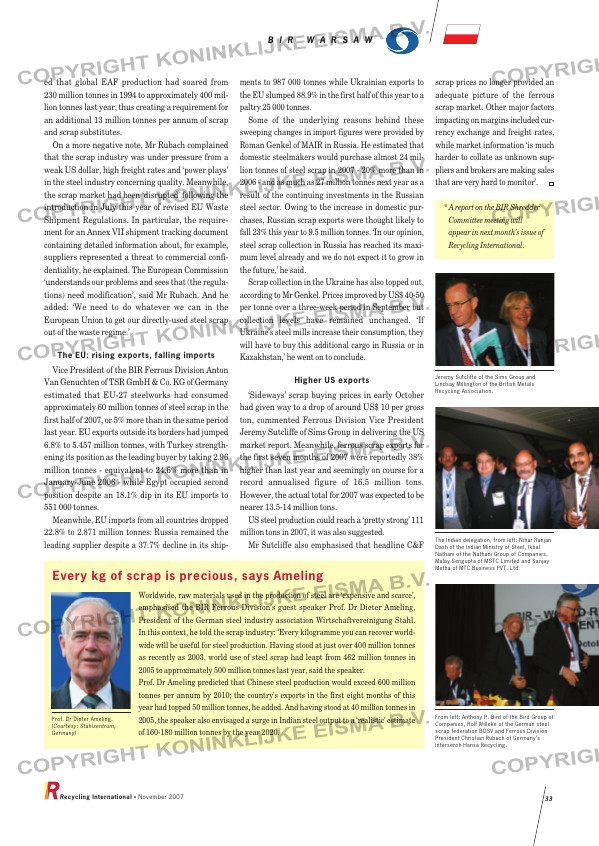Page 33 from: November 2007

ed that global EAF production had soared from
230 million tonnes in 1994 to approximately 400 mil-
lion tonnes last year, thus creating a requirement for
an additional 13 million tonnes per annum of scrap
and scrap substitutes.
On a more negative note, Mr Rubach complained
that the scrap industry was under pressure from a
weak US dollar, high freight rates and ‘power plays’
in the steel industry concerning quality. Meanwhile,
the scrap market had been ‘disrupted’ following the
introduction in July this year of revised EU Waste
Shipment Regulations. In particular, the require-
ment for an Annex VII shipment tracking document
containing detailed information about, for example,
suppliers represented a threat to commercial confi-
dentiality, he explained. The European Commission
‘understands our problems and sees that (the regula-
tions) need modification’, said Mr Rubach. And he
added: ‘We need to do whatever we can in the
European Union to get our directly-used steel scrap
out of the waste regime.’
The EU: rising exports, falling imports
Vice President of the BIR Ferrous Division Anton
Van Genuchten of TSR GmbH & Co. KG of Germany
estimated that EU-27 steelworks had consumed
approximately 60 million tonnes of steel scrap in the
first half of 2007, or 5% more than in the same period
last year. EU exports outside its borders had jumped
6.8% to 5.457 million tonnes, with Turkey strength-
ening its position as the leading buyer by taking 2.96
million tonnes – equivalent to 24.6% more than in
January-June 2006 – while Egypt occupied second
position despite an 18.1% dip in its EU imports to
551 000 tonnes.
Meanwhile, EU imports from all countries dropped
22.8% to 2.871 million tonnes: Russia remained the
leading supplier despite a 37.7% decline in its ship-
ments to 987 000 tonnes while Ukrainian exports to
the EU slumped 88.9% in the first half of this year to a
paltry 25 000 tonnes.
Some of the underlying reasons behind these
sweeping changes in import figures were provided by
Roman Genkel of MAIR in Russia. He estimated that
domestic steelmakers would purchase almost 24 mil-
lion tonnes of steel scrap in 2007 – 20% more than in
2006 – and as much as 27 million tonnes next year as a
result of the continuing investments in the Russian
steel sector. Owing to the increase in domestic pur-
chases, Russian scrap exports were thought likely to
fall 23% this year to 9.5 million tonnes. ‘In our opinion,
steel scrap collection in Russia has reached its maxi-
mum level already and we do not expect it to grow in
the future,’ he said.
Scrap collection in the Ukraine has also topped out,
according to Mr Genkel. Prices improved by US$ 40-50
per tonne over a three-week period in September but
collection levels have remained unchanged. ‘If
Ukraine’s steel mills increase their consumption, they
will have to buy this additional cargo in Russia or in
Kazakhstan,’ he went on to conclude.
Higher US exports
‘Sideways’ scrap buying prices in early October
had given way to a drop of around US$ 10 per gross
ton, commented Ferrous Division Vice President
Jeremy Sutcliffe of Sims Group in delivering the US
market report. Meanwhile, ferrous scrap exports for
the first seven months of 2007 were reportedly 38%
higher than last year and seemingly on course for a
record annualised figure of 16.5 million tons.
However, the actual total for 2007 was expected to be
nearer 13.5-14 million tons.
US steel production could reach a ‘pretty strong’ 111
million tons in 2007, it was also suggested.
Mr Sutcliffe also emphasised that headline C&F
scrap prices no longer provided an
adequate picture of the ferrous
scrap market. Other major factors
impacting on margins included cur-
rency exchange and freight rates,
while market information ‘is much
harder to collate as unknown sup-
pliers and brokers are making sales
that are very hard to monitor’.
Recycling International • November 2007 33
From left: Anthony P. Bird of the Bird Group of
Companies, Rolf Willeke of the German steel
scrap federation BDSV and Ferrous Division
President Christian Rubach of Germany’s
Interseroh Hansa Recycling.
Jeremy Sutcliffe of the Sims Group and
Lindsay Millington of the British Metals
Recycling Association.
Worldwide, raw materials used in the production of steel are ‘expensive and scarce’,
emphasised the BIR Ferrous Division’s guest speaker Prof. Dr Dieter Ameling,
President of the German steel industry association Wirtschaftvereinigung Stahl.
In this context, he told the scrap industry: ‘Every kilogramme you can recover world-
wide will be useful for steel production. Having stood at just over 400 million tonnes
as recently as 2003, world use of steel scrap had leapt from 462 million tonnes in
2005 to approximately 500 million tonnes last year, said the speaker.
Prof. Dr Ameling predicted that Chinese steel production would exceed 600 million
tonnes per annum by 2010; the country’s exports in the first eight months of this
year had topped 50 million tonnes, he added. And having stood at 40 million tonnes in
2005, the speaker also envisaged a surge in Indian steel output to a ‘realistic’ estimate
of 160-180 million tonnes by the year 2020.
Prof. Dr Dieter Ameling.
(Courtesy: Stahlzentrum,
Germany)
The Indian delegation, from left: Nihar Ranjan
Dash of the Indian Ministry of Steel, Ikbal
Nathani of the Nathani Group of Companies,
Malay Sengupta of MSTC Limited and Sanjay
Metha of MTC Business PVT. Ltd.
* A report on the BIR Shredder
Committee meeting will
appear in next month’s issue of
Recycling International.
Every kg of scrap is precious, says Ameling
B I R W A R S A W
RI_035 BIR-Ferrous:Opmaak 1 08-11-2007 09:52 Pagina 33



